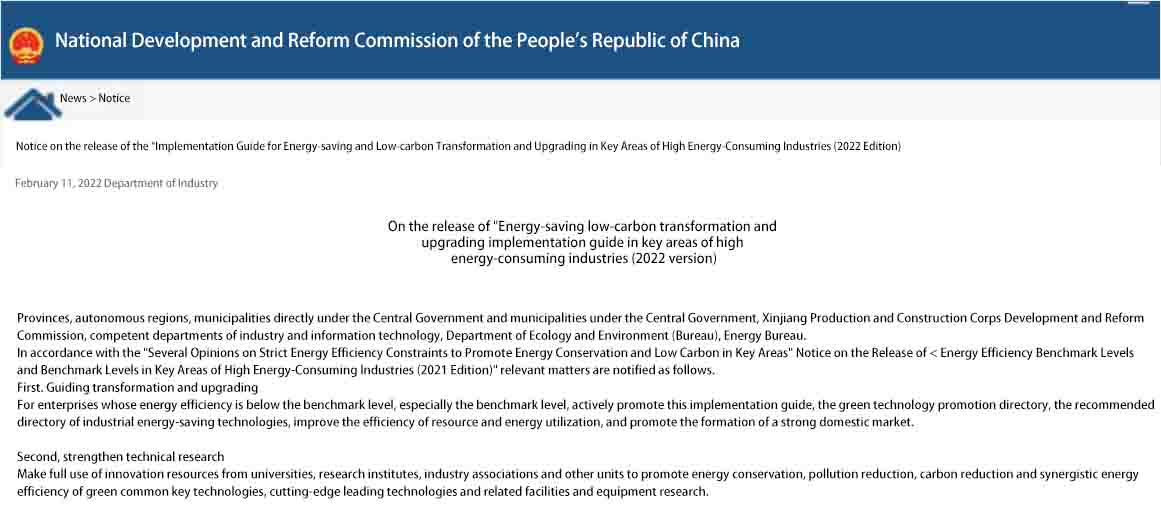2022 Implementation Guidelines For High Energy Consuming Industries Such As Sanitary Ceramics: No Blind Expansion In The Name Of Mergers And Acquisitions
This is the news released by the National Development and Reform Commission on February 11. The National Development and Reform Commission, the Ministry of Industry and four other departments recently jointly issued the “Implementation Guide for Energy-saving and Carbon-reducing Transformation and Upgrading in Key Areas of High Energy-Consuming Industries (2022 Edition)”, which specifies the work direction and objectives of energy-saving and carbon-reducing transformation in the following 17 industries, в тому числі: oil refining, ethylene, paraxylene, modern coal chemical, ammonia, calcium carbide, caustic soda, soda ash, ammonium phosphate, yellow phosphorus, cement, flat glass, steel, coking, Ferroalloys, non-ferrous metal smelting and construction, sanitary ceramics.

The Implementation Guide for Energy Saving and Carbon Reduction Transformation and Upgrading in the Construction and Sanitary Ceramics Industry states that by 2025, the proportion of capacity above the energy efficiency benchmark level in the construction and sanitary ceramics industry will all reach 30%. The capacity below the energy efficiency benchmark level is basically zeroed out. The industry energy-saving carbon reduction effect is remarkable, and the green low-carbon development capacity is greatly enhanced.
According to the “Energy Efficiency Benchmark Levels and Benchmark Levels in Key Areas of High Energy-Consuming Industries (2021 Edition)”, the energy efficiency benchmark level of ceramic tiles with water absorption rate ≤ 0.5% є 4 kg standard coal/m2 and the benchmark level is 7 kg standard coal/m2; the energy efficiency benchmark level of ceramic tiles with 0.5% <water absorption rate ≤ 10% є 3.7 kg standard coal/m2 and the benchmark level is 4.6 kg Standard coal / square meter; water absorption rate of > 10% of the energy efficiency benchmark level of ceramic tile 3.5 kg standard coal / square meter, the benchmark level of 4.5 kg standard coal / square meter; sanitary ceramics energy efficiency benchmark level of 300 kg standard coal/ton, the benchmark level of 630 kg standard coal/ton. By the end of 2020, the energy efficiency of the building and sanitary ceramics industry is better than the benchmark level of production capacity accounting for less than 5%, energy efficiency is less than the benchmark level of production capacity accounted for less than 5%.
The four departments issued a notice pointing out that for energy efficiency in the benchmark level, especially the benchmark level below the enterprise, they actively promote the implementation of guidelines, the promotion of green technology directory, the recommended directory of industrial energy-saving technologies, “Energy Efficiency Star” equipment catalog and other proposed advanced technology and equipment. They should strengthen energy system optimization, waste heat and pressure utilization, pollutant reduction, comprehensive utilization of solid waste and transformation of public and auxiliary facilities, improve the green level of production processes and technical equipment, enhance the efficiency of resource and energy utilization, and promote the formation of a strong domestic market. Guide backbone enterprises to play the advantages of capital, talent, technology and so on. Carry out mergers and acquisitions in this field voluntarily and independently through on the best and eliminate the bad or capacity replacement, тощо, and focus on planning and building large-scale and integrated production bases. Improve their process equipment level and energy utilization efficiency, and build a reasonable structure, effective competition, standardized and orderly development pattern. Do not merge and reorganize in the name of blind expansion of production capacity and low-level duplication of construction.
The notice specifies that the strict implementation of energy conservation, environmental protection, якість, safety technology and other relevant laws and regulations and “Industrial Structure Adjustment Guidance Catalog” and other policies, and in accordance with the law to eliminate backward process technology and production units that do not meet the requirements of green and low-carbon transformation and development. For those whose energy efficiency is below the benchmark level and difficult to reach above the benchmark level through transformation and upgrading in the specified time frame, they will promote their accelerated exit through market-based approaches and rule of law.
 Постачальник заводу кранів iVIGA
Постачальник заводу кранів iVIGA

